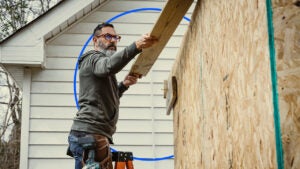Financing home renovations during the holidays: Your how-to guide

Key takeaways
- Personal loans can be a good option to finance home renovations and emergency repairs because they offer quick, flexible funding.
- You can also take out personal loans to work on necessary renovations that could add value to your home without having to tap into your equity.
- In addition, repairing fire or water damage can cost thousands of dollars, especially if they affect the structural integrity of your home.
No one can predict extreme weather or accidents during the holidays, but you do have options if you need to finance repairs or much-needed upgrades for your home. Personal loans, HELOCs and credit cards — on top of your emergency fund — are all solid ways to cover the cost of financing home renovations.
Home renovation and property damage statistics
- The best time of year for renovations is the fall. Demand cools off for contractors, and many are willing to provide a discount to secure jobs for renovations conducted later in the year.
- The National Fire Protection Association (NFPA) states that home cooking fires are more common on Thanksgiving, Christmas Eve and Christmas Day.
- The majority (57 percent) of U.S. adults say they have incurred costs because of an extreme weather event over the last decade, according to data from Bankrate’s Extreme Weather Survey.
- Fires caused by holiday decorations — not including Christmas trees — have resulted in $14 million in direct property damage over the years.
- Water damage is also common during the winter holidays. On average, water damage costs $2,000 to $6,000 to repair.
Options for financing home renovations and repairs
Personal loans are a great option to finance home renovations or repairs during the holidays, but they’re not your only option. For smaller projects, consider using your savings or everyday credit card. For larger projects, you may want to consider tapping your home’s equity.
Savings
“The best way to finance home improvements is to plan for the project and save the money needed for it,” says Vida Jatulis, a financial planner at MainStreet Financial Planning, Inc. “The decision to finance the project depends on current interest rates, how much debt you already have and your ability to make monthly payments on the additional debt.”
Building up your savings in a separate savings account is one of the least expensive ways to pay for a remodel. After all, you’ll be earning interest instead of paying it. You also don’t have to wait for a lender to disburse the funds. These qualities make using savings for renovation a popular choice: 83 percent of renovations are paid for with money from savings, according to data from the Overview of U.S. Renovation in 2024 published by Houzz & Home.
However, saving enough for repairs or renovations could take a long time — especially on top of normal holiday spending. And depleting your savings could also leave you worse off financially if you don’t leave enough money to cover an emergency. Not everyone can afford to pay for these expenses out of pocket, especially when Bankrate’s Annual Emergency Savings Report found that 27 percent of U.S. adults have no emergency savings. For these folks, using some form of credit may be the only option.
Personal loans
If you don’t have the money in savings for general renovations or emergency repairs during the holidays, financing options like personal loans may be useful. Plus personal loans have lower rates than credit cards, making them a less expensive option overall.
Personal loans typically have repayment terms of one to seven years, and you may be eligible to borrow up to $100,000 with some lenders. You can compare personal loan rates and top lenders to determine what will best suit your budget.
Credit cards
With credit cards, you can get money right away and borrow as you see fit. You will be limited by your credit limit and by high interest rates. However, you may be able to avoid interest charges with a 0 percent APR card’s introductory offer or by paying before the due date.
Additionally, you may be able to take advantage of reward programs. This can help you recoup some of the money you spent on the holidays, whether it was for travel, gifts or covering emergency repairs.
Home improvement loans
Home improvement loans are a type of personal loan specifically designed for home renovations or repairs. The main difference is that home improvement loans typically offer longer repayment periods and larger amounts than traditional personal loans. But like other unsecured loans, you can only qualify for the best terms and interest rates if you have excellent credit.
Cash-out refinancing
This option involves replacing your existing mortgage with a larger one, allowing you to take home the difference — your equity. Because a cash-out refi is secured by your equity, interest rates tend to be competitive.
However, choosing this option means you will potentially pay more interest over time. Funding can take weeks, and a lot of paperwork is involved. Most importantly, you risk foreclosure if you default, which is a risk you’d have with any loan secured by your equity.
Home equity loans
Because they use your house as collateral, home equity loans tend to have lower interest rates than personal loans or credit cards. You can also borrow more. Like cash out refinancing, home equity loans are a second mortgage on your home, so if you fall behind on your payments, things could get dicey. Besides that, getting approved for a home equity loan is a weeks-long process, which is something to keep in mind if you need funding to cover an emergency rather than general holiday renovations.
Home equity lines of credit (HELOCs)
A HELOC also uses equity to secure financing. The main difference between HELOCs and home equity loans is that instead of getting a lump sum, you can borrow money as you need up to your credit limit — usually capped at 80 percent of your home’s value.
While a line of credit offers more flexibility than a term loan, you could end up overspending. Additionally, interest rates are variable, so payments can be somewhat unpredictable.
Government loans
The U.S. Department of Housing and Urban Development (HUD) offers several low-cost loan programs to help homeowners make some much-needed repairs. However, these loans tend to have strict requirements and must be used to improve the livability of a space — not just for cosmetic reasons. This means Title I loans can be useful for funding repairs, not renovations.
Costly holiday home repairs
Fire is one of the most common types of property damage during the fall and winter holidays, with most incidents happening in the kitchen, according to the NFPA.
Water damage is common, too. Pipes are at a greater risk of bursting once the temperature drops below 32 degrees Fahrenheit. Damages caused by both fire and water can be expensive to repair, especially if your home suffers structural damage.
Average cost to repair fire damage
Depending on the damage, fire restoration can cost anywhere from $3,114 to $51,485, according to Angi. On average, repairs for fire damage cost $27,299.
The average fire restoration cost ranges from $4 to $6.50 per square foot. That said, these figures assume a full home renovation. The cost can be much less if only a portion of your house was damaged or if you live in a smaller home.
Although cooking-related fires have been decreasing since the 1980s, fires still cause significant structural damage to homes in the U.S. each year. These fire safety tips could help protect your home during the holiday season:
- Buy flame-retardant or flame-resistant decorations.
- Do not hang lights with damaged or exposed wiring.
- Choose flameless decorative candles.
- Turn off Christmas lights before going to bed or leaving the house.
- If purchasing a natural Christmas tree, choose one with fresh, green needles.
Average cost of water damage
The Bankrate Extreme Weather survey also found that 20 percent of Americans have spent money on damage to their home or property because of extreme weather.
Homeowners in the U.S. spend an average of $2,000 to $6,000 to repair water damage, according to HomeGuide. Depending on the severity, costs can reach $100,000. Water damage caused to plaster, hardwood and carpeting are among the most expensive to repair, costing between $2 to $25 per square foot to fix.
That said, water damage is more likely to occur in the states of Florida, Louisiana, New Jersey, New York and Texas, as they’re more prone to flooding. In fact, according to USAFacts, these states account for over a third of flood insurance claims.
Home remodeling during the holidays
When it comes to home remodeling, homeowners tend to focus more on interior rooms, according to a study by Houzz & Home. In 2023, seven out of 10 people who renovated their homes focused on investing in interior room remodeling, and more than half made exterior improvements and updates to their outdoor space.
While home remodeling through the holidays can be chaotic at best, both the fall and winter seasons are great for taking on projects. Demand for contractors cools off, which means you can get more focused attention on your specific project. You may be able to save money, too — home renovation costs range from roughly $19,500 to $88,000, but contractors may be more willing to offer a discounted price to secure a job for their crew during slower months.
Bottom line
Fire and water damage are common hazards during the fall and winter months. When these emergencies arise, they can cost thousands of dollars.
Fortunately, there are multiple ways to cover emergencies and necessary renovations during the holidays. Do your research and shop around for lenders to find the most cost-effective option for your budget.
Why we ask for feedback Your feedback helps us improve our content and services. It takes less than a minute to complete.
Your responses are anonymous and will only be used for improving our website.
You may also like

How to pay for home improvements

7 renovations that can impact your home insurance




